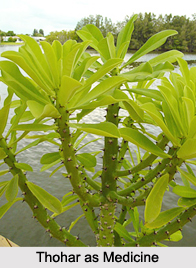 Thohar, a prickly shrub is sacred to Manasa, the goddess of serpents. On the 5th day after full moon of the month of Sravana (July, August) it is planted in the courtyard of Hindu houses and worshipped as the representative of Maa Manasa, the goddess of serpents.
Thohar, a prickly shrub is sacred to Manasa, the goddess of serpents. On the 5th day after full moon of the month of Sravana (July, August) it is planted in the courtyard of Hindu houses and worshipped as the representative of Maa Manasa, the goddess of serpents.
Benefits of Thohar
This plant is supposed to treat ear pain, skin diseases, warts, scabies, etc and is generally kept in tubs or pots on the roofs or other exposed parts of native houses. The milky juice of Euphorbia neriifolia is considered purgative and rubefacient.
Dose of Thohar in Medicine
As a purgative it is generally used in combination with other medicines which are steeped in it. Chebulic myrobalan, long pepper, trivrit root, etc., are thus treated and administered as drastic purgatives, in ascites, anasarca and tympanitis. It enters into the composition of several compound prescriptions of a drastic character as for example, the Mahana racha rasa described under Croton Tiglium, and Vindu ghrita a preparation with clarified butter, of similar composition.
Turmeric powder mixed with the milky juice of Euphorbia neriifolia is recommended to be applied to piles. Thread steeped in the above mentioned mixture is used in ligaturing external hemorrhoids. The powdered wood of Berberis Asiatica (Daruharidra) is steeped in the milky juice of snuhi and of Calotropis gigantea (arka), and made into tents for introduction into the tracks of fistula-in-ano and other sinuses.
This article is a stub. You can enrich by adding more information to it. Send your Write Up to content@indianetzone.com




















